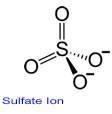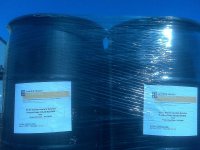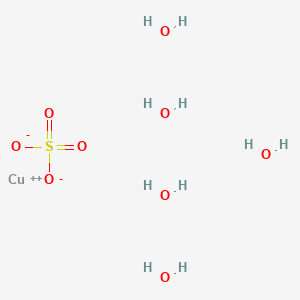SECTION 1. IDENTIFICATION
Product Name: Copper Sulfate Solution
Product Number: All applicable American Elements product codes, e.g. CU-SAT-01-SOL.5HYD
CAS #: 7758-99-8
Relevant identified uses of the substance: Scientific research and development
Supplier details:
American Elements
10884 Weyburn Ave.
Los Angeles, CA 90024
Tel: +1 310-208-0551
Fax: +1 310-208-0351
Emergency telephone number:
Domestic, North America: +1 800-424-9300
International: +1 703-527-3887
SECTION 2. HAZARDS IDENTIFICATION
Classification of the substance or mixture
GHS Classification in accordance with 29 CFR 1910 (OSHA HCS)
Acute aquatic toxicity(Category 1), H400
Chronic aquatic toxicity(Category 1), H410
GHS Label elements, including precautionary statements
Pictogram
Signal word
Warning
Hazard statement(s)
H410
Very toxic to aquatic life with long lasting effects.
Precautionary statement(s)
P273
Avoid release to the environment.
P391
Collect spillage.
P501
Dispose of contents/ container to an approved waste disposal plant.
Hazards not otherwise classified (HNOC) or not covered by GHS-none
SECTION 3. COMPOSITION/INFORMATION ON INGREDIENTS
Mixtures
Synonyms: Cupric sulfate standard
Cas No.: 7758-98-7
SECTION 4. FIRST AID MEASURES
Description of first aid measures
General advice
Move out of dangerous area.
Consult a physician. Show this safety data sheet to the doctor in attendance.
If inhaled
If breathed in, move person into fresh air. If not breathing, give artificial respiration. Consult a physician.
In case of skin contact
Wash off with soap and plenty of water. Consult a physician.
In case of eye contact
Flush eyes with water as a precaution.
If swallowed
Never give anything by mouth to an unconscious person. Rinse mouth with water. Consult a physician.
Most important symptoms and effects, both acute and delayed
The most important known symptoms and effects are described in the labelling (see section 2) and/or in section 11
Indication of any immediate medical attention and special treatment needed
No data available
SECTION 5. FIREFIGHTING MEASURES
Extinguishing media
Suitable extinguishing media
Use water spray, alcohol-resistant foam, dry chemical or carbon dioxide.
Special hazards arising from the substance or mixture
No data available
Advice for firefighters
Wear self-contained breathing apparatus for firefighting if necessary.
Further information
No data available
SECTION 6. ACCIDENTAL RELEASE MEASURES
Personal precautions, protective equipment and emergency procedures
Use personal protective equipment. Avoid breathing vapours, mist or gas. Ensure adequate ventilation. Evacuate personnel to safe areas.
For personal protection see section 8.
Environmental precautions
Prevent further leakage or spillage if safe to do so. Do not let product enter drains. Discharge into the environment must be avoided.
Methods and materials for containment and cleaning up
Soak up with inert absorbent material and dispose of as hazardous waste. Keep in suitable, closed containers for disposal.
Reference to other sections
For disposal see section 13.
SECTION 7. HANDLING AND STORAGE
Precautions for safe handling
For precautions see section 2.
Conditions for safe storage, including any incompatibilities
Keep container tightly closed in a dry and well-ventilated place.
Containers which are opened must be carefully resealed and kept upright to prevent leakage.
Specific end use(s)
Apart from the uses mentioned in section 1 no other specific uses are stipulated
SECTION 8. EXPOSURE CONTROLS/PERSONAL PROTECTION
Exposure controls
Appropriate engineering controls
Handle in accordance with good industrial hygiene and safety practice. Wash hands before breaks and at the end of workday.
Personal protective equipment
Eye/face protection
Safety glasses with side-shields conforming to EN166 Use equipment for eye protection tested and approved under appropriate government standards such as NIOSH (US) or EN 166(EU).
Skin protection
Handle with gloves. Gloves must be inspected prior to use. Use proper glove removal technique (without touching glove's outer surface) to avoid skin contact with this product. Dispose of contaminated gloves after use in accordance with applicable laws and good laboratory practices. Wash and dry hands.
Body Protection
Impervious clothing, The type of protective equipment must be selected according to the concentration and amount of the dangerous substance at the specific workplace.
Respiratory protection
Where risk assessment shows air-purifying respirators are appropriate use a full-face respirator with multi-purpose combination (US) or type ABEK (EN 14387) respirator cartridges as a backup to engineering controls.
If the respirator is the sole means of protection, use a full-face supplied air respirator. Use respirators and components tested and approved under appropriate government standards such as NIOSH (US) or CEN (EU).
Control of environmental exposure
Prevent further leakage or spillage if safe to do so. Do not let product enter drains. Discharge into the environment must be avoided.
SECTION 9. PHYSICAL AND CHEMICAL PROPERTIES
Appearance
Form: liquid
Odor
No data available
Odor Threshold
No data available
pH
No data available
Melting point/freezing point
No data available
Initial boiling point and boiling range
No data available
Flash point
Not applicable
Evaporation rate
No data available
Flammability (solid, gas)
No data available
Upper/lower flammability or explosive limits
No data available
Vapor pressure
No data available
Vapor density
No data available
Relative density
No data available
Water solubility
No data available
Partition coefficient: n-octanol/water
No data available
Auto-ignition temperature
No data available
Decomposition temperature
No data available
Viscosity
No data available
Explosive properties
No data available
Oxidizing properties
No data available
Other safety information
No data available
SECTION 10. STABILITY AND REACTIVITY
Reactivity
No data available
Chemical stability
Stable under recommended storage conditions.
Possibility of hazardous reactions
No data available
Conditions to avoid
No data available
Incompatible materials
Powdered metals, Anhydrous copper(II) sulfate, hydroxylamine, reacts violently with:, Magnesium
Hazardous decomposition products
Hazardous decomposition products formed under fire conditions.-Sulphur oxides, Copper oxides
Other decomposition products-No data available
In the event of fire: see section 5
SECTION 11. TOXICOLOGICAL INFORMATION
Information on toxicological effects
Acute toxicity
No data available
Inhalation: No data available
Dermal: No data available
No data available
Skin corrosion/irritation
No data available
Serious eye damage/eye irritation
No data available
Respiratory or skin sensitisation
No data available
Germ cell mutagenicity
No data available
Carcinogenicity
IARC:
No component of this product present at levels greater than or equal to 0.1% is identified as
probable, possible or confirmed human carcinogen by IARC.
NTP:
No component of this product present at levels greater than or equal to 0.1% is identified as a
known or anticipated carcinogen by NTP.
OSHA:
No component of this product present at levels greater than or equal to 0.1% is identified as a
carcinogen or potential carcinogen by OSHA.
Reproductive toxicity
No data available
No data available
Specific target organ toxicity -single exposure
No data available
Specific target organ toxicity -repeated exposure
No data available
Aspiration hazard
No data available
Additional Information
RTECS: Not available
Symptoms of systemic copper poisoning may include: capillary damage, headache, cold sweat, weak pulse, and kidney and liver damage, central nervous system excitation followed by depression, jaundice, convulsions, paralysis, and coma.
Death may occur from shock or renal failure. Chronic copper poisoning is typified by hepatic cirrhosis, brain damage and demyelination, kidney defects, and copper deposition in the cornea as exemplified by humans with Wilson's disease. It has also been reported that copper poisoning has lead to hemolytic anemia and accelerates arteriosclerosis., To the best of our knowledge, the chemical, physical, and toxicological properties have not been thoroughly investigated.
Liver-Irregularities-Based on Human Evidence
Stomach-Irregularities-Based on Human Evidence(Copper sulphate pentahydrate)
SECTION 12. ECOLOGICAL INFORMATION
Toxicity
No data available
Persistence and degradability
No data available
Bioaccumulative potential
No data available
Mobility in soil
No data available
Results of PBT and vPvB assessment
PBT/vPvB assessment not available as chemical safety assessment not required/not conducted
Other adverse effects
An environmental hazard cannot be excluded in the event of unprofessional handling or disposal.
Very toxic to aquatic life.
SECTION 13. DISPOSAL CONSIDERATIONS
Waste treatment methods
Product
Offer surplus and non-recyclable solutions to a licensed disposal company.
Contact a licensed professional waste disposal service to dispose of this material.
Dissolve or mix the material with a combustible solvent and burn in a chemical incinerator equipped with an afterburner and scrubber.
Contaminated packaging
Dispose of as unused product.
SECTION 14. TRANSPORT INFORMATION
DOT (US)
UN number: 3082
Class: 9
Packing group: III
Proper shipping name: Environmentally hazardous substance, liquid, n.o.s.(Copper sulphate pentahydrate)
Reportable Quantity(RQ): 250 lbs
Marine pollutant:yes
Poison Inhalation Hazard: No
IMDG
UN number: 3082
Class: 9
Packing group: III
EMS-No: F-A, S-F
Proper shipping name: ENVIRONMENTALLY HAZARDOUS SUBSTANCE, LIQUID, N.O.S.(Copper sulphate pentahydrate)
Marine pollutant: yes
IATA
UN number: 3082
Class: 9
Packing group: III
Proper shipping name: Environmentally hazardous substance, liquid, n.o.s.(Copper sulphate pentahydrate)
SECTION 15. REGULATORY INFORMATION
SARA 302 Components
No chemicals in this material are subject to the reporting requirements of SARA Title III, Section 302.
SARA 313 Components
The following components are subject to reporting levels established by SARA Title III, Section 313:
Copper sulphate pentahydrate
CAS-No.
7758-99-8
Revision Date
1993-04-24
SARA 311/312 Hazards
Acute Health Hazard, Chronic Health Hazard
Massachusetts Right To Know Components
Copper sulphate pentahydrate
CAS-No.
7758-99-8
Revision Date
1993-04-24
Pennsylvania Right To Know Components
Water
CAS-No.
7732-18-5
New Jersey Right To Know Components
Water
CAS-No.
7732-18-5
Copper sulphate pentahydrate
7758-99-8
This product does not contain any chemicals known to State of California to cause cancer, birth defects, or any other
reproductive harm.
SECTION 16. OTHER INFORMATION
Safety Data Sheet according to Regulation (EC) No. 1907/2006 (REACH). The above information is believed to be correct but does not purport to be all inclusive and shall be used only as a guide. The information in this document is based on the present state of our knowledge and is applicable to the product with regard to appropriate safety precautions. It does not represent any guarantee of the properties of the product. American Elements shall not be held liable for any damage resulting from handling or from contact with the above product. See reverse side of invoice or packing slip for additional terms and conditions of sale. COPYRIGHT 1997-2022 AMERICAN ELEMENTS. LICENSED GRANTED TO MAKE UNLIMITED PAPER COPIES FOR INTERNAL USE ONLY.

 materials. American Elements can prepare dissolved homogeneous solutions at customer specified concentrations or to the maximum stoichiometric concentration. Packaging is available in 55 gallon drums, smaller units and larger liquid totes. American Elements maintains
materials. American Elements can prepare dissolved homogeneous solutions at customer specified concentrations or to the maximum stoichiometric concentration. Packaging is available in 55 gallon drums, smaller units and larger liquid totes. American Elements maintains  Copper (atomic symbol: Cu, atomic number: 29) is a Block D, Group 11, Period 4 element with an atomic weight of 63.546. The number of electrons in each of copper's shells is 2, 8, 18, 1 and its electron configuration is [Ar]3d10 4s1. The copper atom has a radius of 128 pm and a Van der Waals radius of 186 pm. Copper was first discovered by Early Man prior to 9000 BC. In its elemental form, copper has a reddish-orange metallic and lustrous appearance. Of all pure
Copper (atomic symbol: Cu, atomic number: 29) is a Block D, Group 11, Period 4 element with an atomic weight of 63.546. The number of electrons in each of copper's shells is 2, 8, 18, 1 and its electron configuration is [Ar]3d10 4s1. The copper atom has a radius of 128 pm and a Van der Waals radius of 186 pm. Copper was first discovered by Early Man prior to 9000 BC. In its elemental form, copper has a reddish-orange metallic and lustrous appearance. Of all pure  has a higher electrical conductivity. The origin of the word copper comes from the Latin word 'cuprium' which translates as "metal of Cyprus," as the Mediterranean island of Cyprus was known as an ancient source of mined copper..
has a higher electrical conductivity. The origin of the word copper comes from the Latin word 'cuprium' which translates as "metal of Cyprus," as the Mediterranean island of Cyprus was known as an ancient source of mined copper.. The number of electrons in each of Sulfur's shells is 2, 8, 6 and its electron configuration is [Ne] 3s2 3p4. In its elemental form, sulfur has a light yellow appearance. The sulfur atom has a covalent radius of 105 pm and a Van der Waals radius of 180 pm. In nature, sulfur can be found in hot springs, meteorites, volcanoes, and as galena, gypsum, and epsom salts. Sulfur has been known since ancient times but was not accepted as an element until 1777, when Antoine Lavoisier helped to convince the scientific community that it was an element and not a compound.
The number of electrons in each of Sulfur's shells is 2, 8, 6 and its electron configuration is [Ne] 3s2 3p4. In its elemental form, sulfur has a light yellow appearance. The sulfur atom has a covalent radius of 105 pm and a Van der Waals radius of 180 pm. In nature, sulfur can be found in hot springs, meteorites, volcanoes, and as galena, gypsum, and epsom salts. Sulfur has been known since ancient times but was not accepted as an element until 1777, when Antoine Lavoisier helped to convince the scientific community that it was an element and not a compound.
